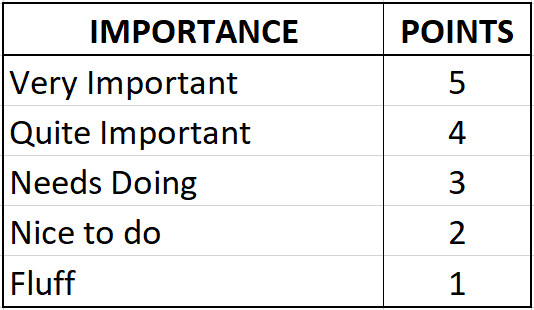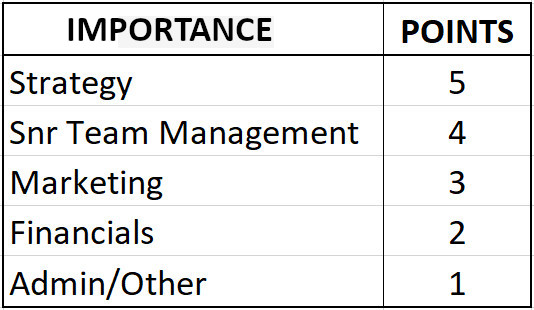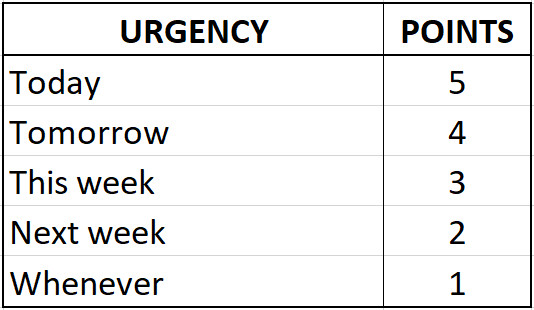9 steps to prioritise your work
When I finally sat down to write this article on Work Prioritisation, it was originally planned to be a description of my own personal Time Management system. However, on reflection, I realised that is actually a ‘Work Prioritisation’ system, rather than a Time Management system. As part of this thought process, I ended up writing this article on 10 issues that affect the amount of time that we actually have in our working days to manage, before we even get to prioritising our workload. I suggest that you read it first, although you can of course simply read this article as a stand alone.
My Work Prioritisation System
Rather than preach ‘YOU MUST USE THIS’ as a priority ordering system, I thought it would be of interest to share my personal system. It works for me, but may not work for others…. You may wish to copy it; you may wish to add aspects into your own system; or you may simply ignore it!
As a little explanation, the system that I use to prioritise my work is my own personal mixture from a number of sources, fine-tuned over my years in business. My system has its foundation in the ‘Urgent vs Important’ matrix from the excellent ‘The 7 Habits of Highly Effective People’ Steven Covey. Take a look at my simple explanation of Covey’s matrix. (If you haven’t read the book yet, you must do so… it is my ‘go-to’ business book).
Rather than simply using Covey’s matrix, I have tweaked it to create a points system. I have then added a ‘quick jobs’ tweak and then overlaid the classic ‘Eat the Frog’ concept.
If you haven’t come across the phrase ‘Eat The Frog’ it seems to have come from a saying from Mark Twain “If it’s your job to eat a frog, it’s best to do it first thing in the morning. And If it’s your job to eat two frogs, it’s best to eat the biggest one first”. It was then taken by a guy called Brain Tracy, apparently a ‘Productivity Consultant’, who popularised it in Time Management theory. Depending on how you interpret it, it either refers to doing the most important task first or doing the task you are most dreading first. The second version takes on procrastination square in the face. In my system I use the second version.
Overview
Ok, so let me first give you an overview of my Work Prioritisation system and then I’ll give you a step-by-step ‘how to’ explanation so that you can use my system too.
Very simply, I score every task on my ‘To Do’ list with a 1-5 points score from ‘unimportant’ to ‘very important’. Next, I go back and score every task on my ‘To Do’ list with a 1-5 points score from ‘no time deadline’ to ‘urgent’. And then finally I score an extra point to each task that takes no more than 5 minutes to complete. Once I have done this, I then total each tasks’ point score, and list the tasks from highest total score to the lowest score. Whilst you don’t have to perform each task in exactly the total points order, it will generally give you a prioritised list of your most important tasks. Eat the Frog? On the list that you have created, there will usually be one stand-out task that you really do not want to do. If you don’t do it first you’ll simply worry or fret about it all day. Do that task first and everything else you do during the day will be easier, and you won’t have it hanging round you all day!
So, let’s take the above system step-by-step in a little more depth and you can get more of an understanding of how to do it, and hopefully see how it could help you, if you chose to use it.
Depending on the frequency that you perform this, the whole process shouldn’t take more than 5 – 10 minutes.
Step 0
If you wish to use my Work Prioritisation system, you will need to create two Points Tables. Firstly you need to create your own ‘Importance’ points table. There are two ways that you can do this. The first version is simply to rank from ‘Very Important’ to ‘Not at all Important’ (I call it ‘fluff’). This list is a generic one and can be used by anyone. This is the one I used below;

The other way to rank by importance is to use the type of work that needs doing. So, for example, you may have five (or more) areas of responsibility. You could rank those areas by importance. So for example, as a business owner ‘company strategy’ would rank higher than say ‘marketing’ or ‘recruitment’ (if they are under your remit). Ranking by importance this way creates a personalised system just for you. Yours may well be very different to mine, but below is an example of an Importance ranking that I used as a Business Owner;

Your second Points Table is more straight forward. You simply rank from ‘Urgent’ to ‘Any time’. I always used the assumption that I was working on Day One of the working week (I assume Monday) so my ‘Urgency’ points table looked like this;

Having now created your two Points Tables, you are ready to start the process.
Step 1
If you haven’t already, make a long, long list of absolutely everything that you have on your ‘To Do’ list. There is no need to put this in any order, just brain dump everything. If you have large task to do, particularly one of those that you won’t be able to complete in one ‘sitting’, break it down into bitesize chucks, and specifically identify which is the first task.
Step 2
Identify what you can delegate. And take it out of your list. Make a separate list of what tasks these are and who to delegate them to. Read more about how to delegate here.
Step 3
Take your ‘Importance’ Points Table and work your way down your whole ‘To Do’ list and give each task on the list a score from your table, relative to how important the task is.
Step 4
Take your ‘Urgency’ Points Table and once again, work your way down your whole ‘To Do’ list and give each task a score from this table too, relative to how urgent the task is. I sometimes use a different colour pen for the two types of scoring but this is not necessary, it just helps me.
Step 5
Take a look at your ‘To Do’ list and as you look down it, score an extra ‘bonus’ point to any task that will take you no more than 5 minutes to complete. Be strict with this. If you are not sure then don’t score the additional point.
Step 6
Now work your way down your list and put a total score (Important points + Urgency points + Bonus points) next to each task. As a tip I circle this total score, or again use a different colour pen, to make these totals stand out from the other points. I also cross out the points as I do the totalling.
Step 7
Take a new sheet of paper and list your tasks in the order of their points totals, from the largest total to the smallest. You do not need to write the score next to each task as you list them. If you have tasks with equal points, list the one with the higher ‘Importance’ points first. If they’re equal on both types of points then it’s your call which you want to write down first.
Step 8
You now have a prioritised list of tasks for you to work through from top to bottom.
Take another piece of paper. Copy the top five tasks onto it. Place your first piece of paper, with the full list on in a drawer, or out of site. Your sheet with the five most important tasks on it is now your ‘To Do’ list. We do this because realistically, if these really are important, you aren’t going to complete any more than five today. But if you do, there’s a nice pyschological buzz in completing all your tasks in a day.
Step 9
So now we start on our tasks. Inevitably there will be at least one ‘Frog’ in your list. You’ll know it. It will be the one task staring out at you from the page, making your stomach churn; the one you really dont want to do, but really should. EAT THAT FROG – do that task first – and once you have, everything else that you work on will be much more enjoyable. After ‘Eating Your Frog’ simply pick up the first task at the top of the list and starting working on that one.
Whilst I would always recommend that you do indeed perform the first task first, it doesn’t HAVE TO be that one first. This process will ensure that, even if you don’t work exactly from the first job down, as long as you are working on one of the five tasks close to the top of the list, you are working on the tasks that best use your time, and allow you to add the most value to the business.
I presented all of the above to a networking group in January 2021. Please watch below.
FAQs
How regularly should I do this Work Prioritisation task?
I tended to do this task first thing on a Monday morning, once a week. Depending on your workload, what gets added by others to your list and your success in working your way through the list, you may need to do this more than once a week, or even less than once a week.
Do I need to stick to the list religiously from first to second to third and on…?
As long as you are generally working on the tasks at or near the top of the list, then you are using your time effectively. What you will also find is that if you are working on tasks near the bottom of the list, just by seeing them down at the bottom, should be a warning sign to you that you are not best using your time.
What happens to the tasks that are at the bottom and never get done?
Frankly, hard cheese! By being at the bottom of the list these tasks have proven their ‘worth’. In all probability they either don’t need doing or can be delegated to someone else.
What happens to jobs that I put ‘Next week’ when next week comes round?
When you re-do your priority list, these tasks will naturally become more time sensitive, score more points and move up your list.
What Next?
If you found the above useful then you can also see and hear more of my discussions, interviews and webinar appearances here.
If you’d like to discuss how I could help you regarding you not being ‘lonely at the top’, or you feel you need a Business Sounding Board, then please give me a call, drop me an email or connect with me on LinkedIn. Details below. I’ll be happy to have chat with you to explore how I may be able to help you. I’ll be honest and I may not be able to help you myself and in that scenario I’ll try and point you in the right direction. However, you might find a peer-to-peer business mentoring group is better for you.
Still unsure if I can help you? Take a look at What you’ll get from me and what my clients say about me.
If you’d like to receive great advice, tips and tales like the topic discussed in this podcast, to help you on your business journey, make sure you don’t miss out on my FREE newsletter ‘Nous of Fraser’. Sign up here.